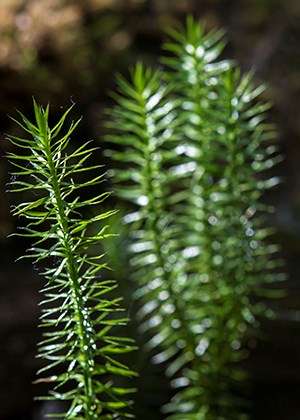
NPS/Tim Rains Moonwort ferns are very small and have a single leaf and a single fertile spike. Moonworts produces spores which disperse through the soil instead of the air and water like most ferns. Because the spores don't travel long distances, the various species frequently hybridize and often form fertile hybrids which become new species. A new species of moonwort fern recently discovered in Glacier Park is currently being described. Club mosses are small, ground-cover variants of ferns which display a greenish "club" spore capsule. Native people used the spores as a blood-clotting agent and wound dressing, and occasionally threw it into fires as "flash-powder" for special effects during ceremonies. Rough horsetail (scouring rush) grows as a single spike in wet areas. It has so much silica in the stem that it can be used as an abrasive scrubber. Horsetails are primitive plants which can be found in fossil records dating back over 300 million years. |
Last updated: May 22, 2016
